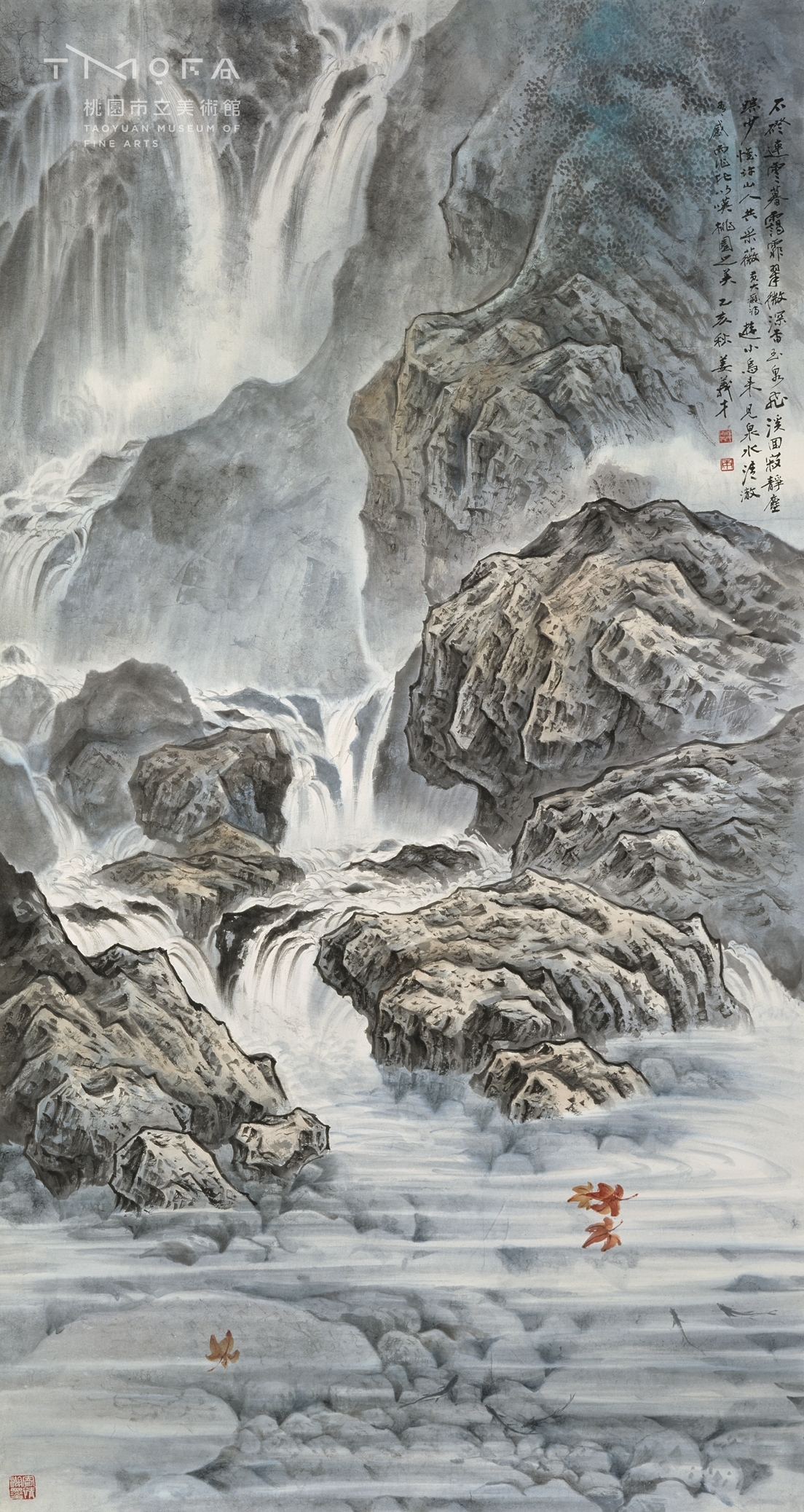Published on:2020-10-16Views:10

Artwork Analysis
This painting by Chiang Yi-Tsai (1973-) features mountain streams cascading to form clear ponds with fish swimming in them and a few red maple leaves floating on the surface, a scene straight out of wonderland. The painter’s inscription: "The stone-paved path leads to the clouds, dense mists at dusk; recluse mountain twists reveal a winding stream. One’s presence is quietly echoed by the river. Perhaps only the mountain recluse is invited to retreat into anonymity here. A poem by Huang Da-Chi. The painting was created in awe of the beauty of Taoyuan after witnessing the clear mountain springs during a visit to the Xiao Wulai Waterfall. Chiang Yi-Tsai, Autumn, Year of Yi Hai." Name seal: "Painted by Yi-Tsai" (intaglio), "Chiang" (relief).
Marked by a rigid composition, this painting depicts a clear pond with a visible bottom in the foreground, galloping waterfalls in the middle ground and swirling mists in the background. The waterfall cascades down through the boulders with an S-shaped movement, full of such energy that one can hear the music of the waterfall as it flows down. In terms of handling the emptiness and fullness, the painter divided the scroll with an invisible bottom-left to upper-right diagonal. On the right side of the scroll are coarse boulders sketched with thick lines in the foreground and the middle ground. Small axe-cut strokes have been applied to depict the boulders’ jagged texture and rich gradations and patterns. The surface is lightly smudged with reddish-brown and flower blue pigments to create a three-dimensional effect of changing light and shade. The mountain peaks are covered with dense dots in the style of Fan Kuan as a reference to Song-dynasty ink painting. On the left of the diagonal line are layers of boulders smudged in light ink and flower blue pigments that exude enchanting poetics and form a contrast of emptiness and fullness and strength and gentleness with the substance of the scraggy crags. The transparency of the clear pond with a visible bottom and the realistic treatment of the light and shade is imbued with a sense of modernity, highlighting an ingenious fusion of ancient and modern techniques. The painter’s inscription clearly indicates the calligraphic style of Chang Dai-Chien (1899-1983), the calligraphy and ink painting master of modern times.
Chiang admitted that he "learned from wide-ranging sources and from the best practitioners, seeking the heritage of painting and new territories for cultivation from the history of art." During his student days, Chiang frequented the National Palace Museum to learn from the masters of all dynasties in order to extract their essence and come up with his own innovative new style that is elegant and refreshing. This painting came in second place in traditional Chinese Painting category of 14th Taoyuan Fine Arts Exhibition.
Marked by a rigid composition, this painting depicts a clear pond with a visible bottom in the foreground, galloping waterfalls in the middle ground and swirling mists in the background. The waterfall cascades down through the boulders with an S-shaped movement, full of such energy that one can hear the music of the waterfall as it flows down. In terms of handling the emptiness and fullness, the painter divided the scroll with an invisible bottom-left to upper-right diagonal. On the right side of the scroll are coarse boulders sketched with thick lines in the foreground and the middle ground. Small axe-cut strokes have been applied to depict the boulders’ jagged texture and rich gradations and patterns. The surface is lightly smudged with reddish-brown and flower blue pigments to create a three-dimensional effect of changing light and shade. The mountain peaks are covered with dense dots in the style of Fan Kuan as a reference to Song-dynasty ink painting. On the left of the diagonal line are layers of boulders smudged in light ink and flower blue pigments that exude enchanting poetics and form a contrast of emptiness and fullness and strength and gentleness with the substance of the scraggy crags. The transparency of the clear pond with a visible bottom and the realistic treatment of the light and shade is imbued with a sense of modernity, highlighting an ingenious fusion of ancient and modern techniques. The painter’s inscription clearly indicates the calligraphic style of Chang Dai-Chien (1899-1983), the calligraphy and ink painting master of modern times.
Chiang admitted that he "learned from wide-ranging sources and from the best practitioners, seeking the heritage of painting and new territories for cultivation from the history of art." During his student days, Chiang frequented the National Palace Museum to learn from the masters of all dynasties in order to extract their essence and come up with his own innovative new style that is elegant and refreshing. This painting came in second place in traditional Chinese Painting category of 14th Taoyuan Fine Arts Exhibition.
Artist Profile
More information coming soon.